Welcome to the finest baseball pitch grips resource! This thorough guide will offer you with the information you need to master the art of pitch grips, whether you're an aspiring pitcher or a baseball lover trying to enhance your knowledge. We'll look at several pitcher grips, their benefits, and how they can improve your overall effectiveness on the mound.
Knowing the Importance of Pitch Grips
Pitch grips are an important part of a pitcher's arsenal. Pitchers can fool batters, keep them off balance, and boost their chances of success on the field by managing the rotation, speed, and movement of the ball. To develop a broad repertoire and keep hitters guessing, it's critical to acquire and understand different pitch grips.
Four Seam Fastball Pitch Grip
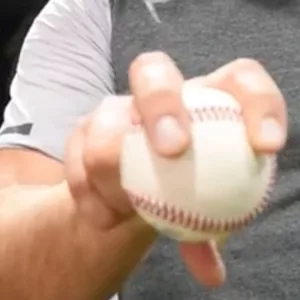 One of the most basic pitches in baseball is the four-seam fastball. It's a pitch recognized for its high velocity and little movement, making it difficult for batters to track. To catch a four-seam fastball:
One of the most basic pitches in baseball is the four-seam fastball. It's a pitch recognized for its high velocity and little movement, making it difficult for batters to track. To catch a four-seam fastball:
- Place your index and middle fingers across the baseball's narrow seams, with your fingertips on top.
- For stability and control, place your thumb beneath the ball.
- To optimize velocity upon release, keep your grip relaxed.
The four-seam fastball is often thrown at a high velocity, making it an excellent pitch for batters with a lot of power.
2 Seam Fastball Pitch Grip
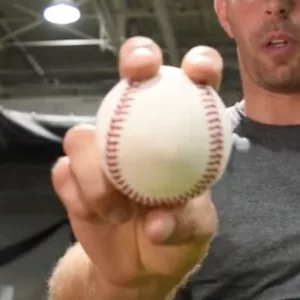 The sinking fastball, or two-seam fastball, adds movement to your pitching arsenal. It has a natural sinking movement that might result in ground balls and weak contact. Gripping the two-seam fastball:
The sinking fastball, or two-seam fastball, adds movement to your pitching arsenal. It has a natural sinking movement that might result in ground balls and weak contact. Gripping the two-seam fastball:
- Place your index and middle fingers across the baseball's narrow seams, like you would for a four-seam fastball.
- To create a rotational spin, shift your fingers slightly to the right for right-handed pitchers (left for left-handed pitchers).
- Rest your thumb against the side of the ball for added control.
The two-seam fastball is a great pitch for creating ground balls and weak swings.
Changeup Pitch Grip
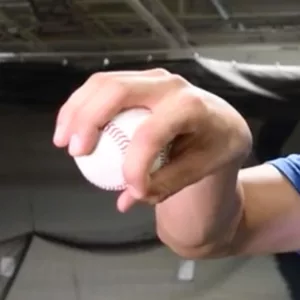 The changeup is an off-speed pitch with low velocity that is intended to fool batters. To sell the illusion effectively, adequate grip and arm speed are required. To grasp the changeup:
The changeup is an off-speed pitch with low velocity that is intended to fool batters. To sell the illusion effectively, adequate grip and arm speed are required. To grasp the changeup:
- Place your three fingers (middle, ring, and pinky) across the baseball's seams.
- When opposed to a fastball grip, dig your fingertips somewhat further into the ball.
- Make a loose grip by drawing a circle with your thumb and index finger.
The changeup is based on the pitcher's ability to maintain arm speed while deceiving the batter with the mechanics of a fastball delivery.
Cutter Pitch Grip
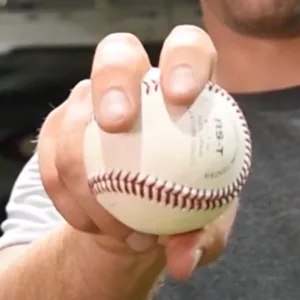 The cutter is a pitch that combines the velocity of a fastball with late-breaking movement. It is also known as a cut fastball or cuttery. It's a powerful tool for causing weak contact and producing ground balls. To hold the cutter:
The cutter is a pitch that combines the velocity of a fastball with late-breaking movement. It is also known as a cut fastball or cuttery. It's a powerful tool for causing weak contact and producing ground balls. To hold the cutter:
- Similar to a four-seam fastball grip, place your index and middle fingers across the baseball's narrow seams.
- For right-handed pitchers, place your middle finger slightly off-center to the right (left for left-handed pitchers).
- Maintain a tight grasp with your index finger while applying slight inward pressure with your middle finger.
Pitchers can use the cutter grip to create lateral movement towards the throwing arm side, making it difficult for batters to square up the pitch. To achieve the desired movement and deception, it is critical to maintain consistency in release and arm speed.
The cutter is a good pitch to use against opposite-handed batters because it moves away from their swings, jamming them or creating weak contact. It's also beneficial for inside pitching since it can tangle up and shatter the bats of same-handed hitters.
Pitchers who used the cutter as their signature pitch, like as Mariano Rivera, have demonstrated its efficiency at the highest level of baseball. Incorporating the cutter into your pitching arsenal can give another depth to your arsenal and keep batters guessing.
Remember that repetition and practice are essential for gaining command and consistency with the cutter. Experiment with different grips, release points, and arm angles to see which ones work best for you. The cutter may become a powerful weapon in your pitching arsenal with focus and correct execution.
Curveball Pitch Grip
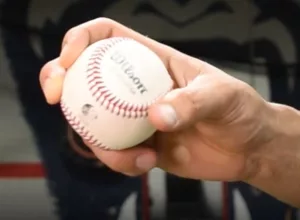 The curveball is a breaking pitch that is distinguished by its sharp downward movement. The curveball grip must be mastered in order to get the appropriate break and control. To catch the curveball:
The curveball is a breaking pitch that is distinguished by its sharp downward movement. The curveball grip must be mastered in order to get the appropriate break and control. To catch the curveball:
- Connect your index and middle fingers across the upper curve of the horseshoe-shaped seam.
- Align your fingers on top of the seam for a solid grip and maximum spin.
- Stabilize the ball by resting your thumb against the bottom.
To achieve the proper spin and movement, the curveball requires a snapping motion upon release.
Slider Pitch Grip
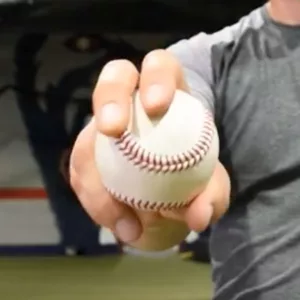 The slider is a versatile pitch that combines fastball and breaking ball components. It has late movement and can be difficult for hitters to track. To hold the slider:
The slider is a versatile pitch that combines fastball and breaking ball components. It has late movement and can be difficult for hitters to track. To hold the slider:
- Place your index and middle fingers just off the center of the ball, with your middle finger closer to the outer seam.
- To create side spin, tilt your wrist slightly inward.
- For added stability, place your thumb against the bottom seam.
The grip and delivery of the slider should be similar to that of a fastball, tricking the batter until the pitch's late-breaking stage.
Knuckleball Pitch Grip
The knuckleball is a distinctive and unpredictable pitch that deceives batters due to its lack of spin. It necessitates a certain grip and a precise release. Gripping the knuckleball:
- Spread your fingers around the seams of the baseball, avoiding contact with the core of the ball.
- Extend your nails somewhat, with your fingertips serving as the principal point of contact.
- Because this pitch relies on minimal spin, avoid holding the ball too strongly.
The irregular movement of the knuckleball can confuse batters, making it a difficult pitch to master yet incredibly effective when delivered correctly.
Developing Command and Repertoire with Pitch Grips
 Understanding different pitch grips is important, but so is developing command and consistency with each pitch. Here are some pointers to help you improve your pitching repertoire:
Understanding different pitch grips is important, but so is developing command and consistency with each pitch. Here are some pointers to help you improve your pitching repertoire:
- Practice, Practice, Practice: Repetition and regular practice are essential for improving your pitch grips and general technique. Concentrate on consistency and accuracy.
- Work with a Coach: Seeking advice from an experienced coach can provide vital insights and aid in the fine-tuning of your mechanics and delivery.
- Use film analysis to find any weaknesses or areas for improvement in your pitching mechanics. It can provide visual feedback and help with modifications.
- Study Opposing batters: Understanding opposing batters' strengths and weaknesses will help you strategize your pitch selection and exploit their vulnerabilities.
- Mental Preparation: Build mental toughness and focus, as pitching demands poise and the ability to make quick adjustments in game settings.
TopVelocity Pro Pitch Analytics System can take your pitching to the next level!
 Are you ready to improve your pitching performance? Consider the TopVelocity Pro Pitch Analytics System! Unleash the power of advanced analytics to learn more about your pitching mechanics, velocity, and general success on the mound.
Are you ready to improve your pitching performance? Consider the TopVelocity Pro Pitch Analytics System! Unleash the power of advanced analytics to learn more about your pitching mechanics, velocity, and general success on the mound.
TopVelocity Pro provides you with cutting-edge technology that analyzes your pitching data and provides individualized feedback and practical recommendations. This technique is meant to help you reach your greatest potential, whether you're a professional pitcher, a college athlete, or a determined amateur.
Why should you use TopVelocity Pro?
- Comprehensive Analysis: Gain a deep understanding of your pitching mechanics, release point, arm speed, and more through detailed analytics and visualizations.
- Velocity Enhancement: Identify areas for improvement and receive customized drills and exercises to increase your pitching velocity and overall performance.
- Performance Tracking: Track your progress over time, monitor key metrics, and compare your performance to elite pitchers to benchmark your growth.
- Personalized Coaching: Benefit from expert guidance and support from experienced coaches who will guide you through the analysis, interpretation, and implementation of the data.
Don't pass up this chance to improve your pitching performance. Visit topvelocity.net/proanalysis to discover more about TopVelocity Pro Pitch Analytics System and how it can help you unleash the full potential of your throwing ability.
Invest in your future as a dominant pitcher today and see how data-driven insights may improve your effectiveness on the mound. Don't put it off any longer; begin your quest to throwing perfection right now!




